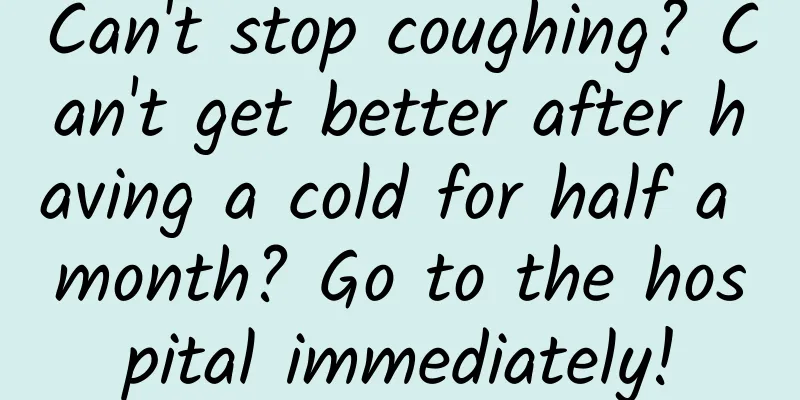Can't stop coughing? Can't get better after having a cold for half a month? Go to the hospital immediately!

|
Recently, influenza A, influenza B, syncytial virus , etc. Various respiratory diseases are coming one after another "Mycoplasma pneumonia" is frequently searched It also caused many people to be recruited Are you confused too? The baby has had a cold for half a month and still hasn't recovered. Is it Mycoplasma pneumonia? The symptoms of mycoplasma pneumonia are very similar to those of influenza. How to determine whether you have mycoplasma pneumonia? Come and copy the answers with me First of all, we need to know what mycoplasma is : Mycoplasma is a type of smallest prokaryotic cell-type microorganism with a size of 0.1 to 0.3 microns that has no cell wall, is highly polymorphic, can pass through filters, and can be cultured and proliferated in artificial culture media. Because they can form filamentous and branched shapes, they are called mycoplasmas. Mycoplasma pneumonia is a lower respiratory tract infection caused by Mycoplasma pneumoniae, with the main symptoms being cough and fever . Image source: Photo Network Mycoplasma pneumonia is spread in a variety of ways, including: Airborne Mycoplasmas are usually transmitted through respiratory secretions , such as droplets or aerosols. Infected people can release mycoplasma when coughing, sneezing or talking, and healthy people can be infected by inhaling them . Image source: Photo Network Close contact Direct contact with infected secretions or infected surfaces is also one of the routes of transmission. Sexual transmission Mycoplasma can also be transmitted through the reproductive tract during sexual intercourse, with Ureaplasma urealyticum being more common. Although the mortality rate of mycoplasma pneumonia is not high, the symptoms it causes are very wide, such as: Cough: Dry or with phlegm, which may be mucus-like. Flu symptoms: fever, chills, and general malaise. Sore throat: Discomfort or pain in the throat. Shortness of breath: Rapid breathing or feeling like you have trouble breathing. Chest pain: Discomfort or pain in the chest may occur. Headache: May be accompanied by headache or body aches. Fatigue: prone to fatigue and weakness. Loss of appetite: decreased interest in food and loss of appetite. After reading this, do you also find that the symptoms of mycoplasma pneumonia are very similar to those of influenza? So how do you tell if you have mycoplasma pneumonia? Remember these 4 points: 1 symptom Patients with Mycoplasma pneumonia may or may not have any dry or wet rales when auscultated. Therefore, if the symptoms of fever, dry cough, sore throat, runny nose and sneezing persist for 2-3 weeks, it is necessary to rule out infection with Mycoplasma pneumoniae . 2 Chest x-ray or chest CT Mycoplasma pneumonia will have interstitial changes in the early stages, with increased and thickened lung texture, presenting as lattice shadows , and further progression will lead to infiltrative and patchy shadows. Image source: Photo Network 3 Complete blood test Routine blood examination generally shows normal blood counts, but severe infection may also result in a slight increase in white blood cells and neutrophils. 4 Detection of antigens, antibodies and nucleic acids To detect whether a patient is infected with Mycoplasma pneumoniae, antigen-antibody and nucleic acid tests are used. The most commonly used method is to draw blood to check for mycoplasma antibody IgM positivity, which can tell whether the patient is in the stage of infection with Mycoplasma pneumoniae . For patients who are highly suspected of Mycoplasma pneumonia clinically but have negative Mycoplasma antibodies , Mycoplasma nucleic acid testing of respiratory secretions can be performed for diagnosis . Maintain good personal hygiene Wash your hands frequently and avoid touching your mouth, nose, and eyes , especially after touching potentially infected surfaces. Image source: Photo Network Wear a mask Especially during high-incidence periods of infection or in crowded crowds , wearing a mask can help reduce the risk of transmission of respiratory droplets. Avoid close contact with infected people Try to avoid close contact with infected people , especially if they cough or sneeze. Sexual protection Use protective measures such as condoms to reduce the risk of sexual transmission. Maintain good ventilation Maintaining good ventilation in homes and workplaces can help reduce the concentration of airborne pathogens. Image source: Photo Network Of course, infected people should also pay attention to cough etiquette and cover their coughs or sneezes with a tissue or forearm . If you are infected with Mycoplasma pneumoniae, don't panic. The following treatments can help you get through the difficult times: The treatment of Mycoplasma pneumoniae infection is mainly with macrolide drugs such as erythromycin or azithromycin . Fluoroquinolones such as ciprofloxacin and levofloxacin can also be selected. The tetracycline doxycycline is also effective . Image source: Photo Network The treatment course can be as short as 1-2 weeks or as long as 3-4 weeks, or even longer; generally the treatment course is 2-3 weeks. For mild Mycoplasma pneumoniae infection , you can take azithromycin orally, such as Xishumei, 3 days a week and stop for 4 days . Patients with more severe symptoms may require intravenous infusion . If there is phlegm, it is important to expectorate it effectively , such as turning the child over and patting his back more often to promote coughing up of phlegm, taking appropriate cough suppressants and expectorants, or performing nebulization inhalation . It should be noted that after mycoplasma infection, it takes a long time for mycoplasma antibodies to disappear. If the symptoms disappear, you can stop taking the medicine without having to wait until the mycoplasma antibodies become negative. Image source: Photo Network If you still have symptoms of cough and sputum after using azithromycin for 3-4 weeks, you should consider whether you have a bacterial infection or an allergic (airway hyperresponsiveness) cough after infection . You need to go to the hospital for follow-up appropriate treatment. Important! If the symptoms do not improve after self-adjustment, you must seek medical attention in time ! at last Everyone must take preventive measures Have a firm determination to change your hygiene habits and persistent action This will reduce the chance of contracting infectious diseases! Statement: This article is a medical-related educational popular science article. It does not involve specific treatment methods or medical behaviors and cannot replace hospital visits. Author This article is guided by the teacher Content Production Editor: Yang Yali Map: Eastern Zhou Dynasty |
>>: A busy city is also a paradise? A forest city that Tao Yuanming could never have imagined!
Recommend
Why does our body need calcium?
Many people may have noticed that calcium supplem...
Start a course (completed) Didi Certified Senior Big Data Engineer Training Program
Start a course (completed) Didi Certified Senior ...
There are three levels of product marketing. Which one are you in?
I have also mentioned in previous articles that s...
The reason why potato chips are so delicious is closely related to their growth
It’s the autumn outing season again, and if we ta...
Online Qianchuan System Course "Qianchuan Explains"
1. Course Introduction Online Qianchuan System Co...
Hello 5C, Goodbye 5C.
According to Taiwan's Commercial Times, Apple...
How much does it cost to produce a Hulunbuir Electrical mini program?
The mini program provides convenience for publici...
How to plan a large-scale promotional event?
What are the big promotions? It generally refers ...
Long March 3B rocket launches successfully! China's space program ends perfectly in 2021
At 0:43 on December 30, 2021, my country successf...
Methodology for creating popular Tik Tok videos!
Everyone has basically entered the Douyin channel...
Behind the rumors of Google entering China: the market structure has been determined or it may not adapt to the local environment
"Is Google Play really going to enter China ...
A tearful suggestion on advertising purchased with a budget of 1 million
Summary of advertising placement on 7 major chann...
2021 Yixiantian system development plan Yixiantian chip tactics video + indicators
2021 Yixiantian System Development Plan Yixiantian...
These 3 information flow cases increased my monthly salary to 30,000!
Next, let’s look at some interesting cases. Case ...
Take you to catch the "ghost" in the fossil
Produced by: Science Popularization China Author:...









